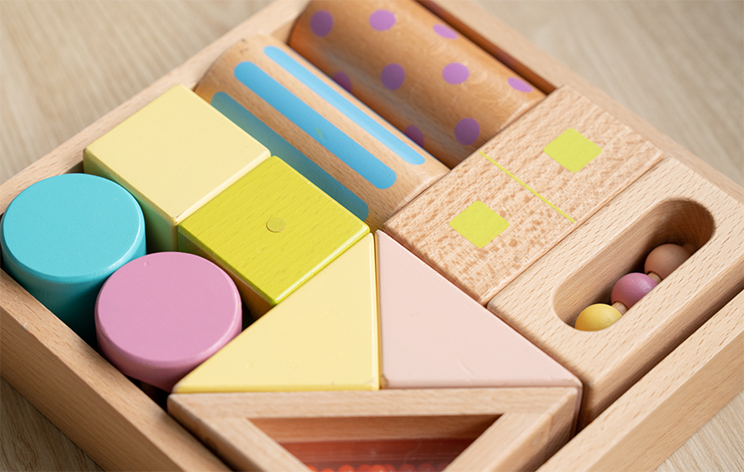HOME > ABOUT > Eight Areas
Montessori Education -
8 Areas of Montessori Education
What is Montessori education? Why do we need to implement Montessori education? For more than a century, the Italian doctor and educator Maria Montessori has created a child-centered education method and a world-changing view of education.
After entering the Montessori classroom, parents will know the changes that have taken place in their children. The uniqueness of Montessori education is very different from other types of classrooms. We allocate classrooms to eight education areas: daily life education, language education, and basic education. Movement education, mathematics education, sensory education, art, music education, science education, and cultural education. Parents can see their children show independent and teamwork learning. In Montessori education we call teaching aid operation work because of Dr. Maria Montessori It is believed that everyone is born with the ability to work, so everyone must develop the ability to work from an early age.
After entering the Montessori classroom, parents will know the changes that have taken place in their children. The uniqueness of Montessori education is very different from other types of classrooms. We allocate classrooms to eight education areas: daily life education, language education, and basic education. Movement education, mathematics education, sensory education, art, music education, science education, and cultural education. Parents can see their children show independent and teamwork learning. In Montessori education we call teaching aid operation work because of Dr. Maria Montessori It is believed that everyone is born with the ability to work, so everyone must develop the ability to work from an early age.
Practical Life
Language
Hand Exercises
Mathematics
Sensorial
Art and Music
Science
Cultural
Practical Life
Care of The Person
Practical Life Education Content: life education, social etiquette, taking care of yourself, taking care of others, caring for the environment
The content of children's learning activities in the daily life learning area includes; classroom routines and etiquette, self-control learning, self-care learning and environmental health learning. Use daily life education to provide a learning environment suitable for children. The activities are carried out in the form of individual, group, and group activities, which are conducive to individual differences in children's learning, provide opportunities for children's social interactions, help adapt to the learning of collective life, and allow each child to get more daily life experience through observation Or through the process of free learning. Daily life education through real-life appliances that conform to the children's usage habits will stimulate children's learning motivation. It is precisely because children are exposed to these daily utensils and frequently used utensils that they can establish a sense of intimacy and learn the correct way to use them. Encourage children to develop a broader field of life and study. The child is born with work and daily housework, and the child enjoys it. For example: flower arranging, mopping the floor, wiping the table, putting on and taking off exercises, etc. Through the practice of teaching aids, children learned to take care of themselves, help themselves, and care for the environment.



Language
Practice Language
Practice Language
Provide suitable learning content according to the individual differences of children, assist the development of keen and emotional language experience, from visual, auditory, perceptual experience, and rich vocabulary. The content of language activities includes: listening activities, speaking performance, writing performance, understanding of Chinese and English, learning of reading, understanding of part of speech functions, and application of part of speech integration. Chinese education makes use of life-oriented learning methods to make children feel intimacy and belonging in the learning process, and at the same time becomes a kind of stimulation for children's language development. The content of language activities includes: listening activities, speaking performance, writing performance, understanding of Chinese and English, learning of reading, understanding of part of speech functions, and application of part of speech integration. Chinese education makes use of life-oriented learning methods to make children feel intimacy and belonging in the learning process, and at the same time becomes a kind of stimulation for children's language development.



Hand Exercises
Self-development, Self-care Ability Practice
Basic Movement Education Content: exercises such as scooping, inverting, pinching, turning, inserting, cutting, sticking, etc.
Hands are the most important teachers of children. Movement is one of the most important items in the early development of life. From the point of view of actions, actions are not only self-expression, but also an indispensable factor in the process of children's mental development. The hand is one of the unique characteristics of human beings, and it is also one of the body movements most closely related to human beings. By grasping the hands, let the children focus on a certain task. Through the operation of both hands, repeated practice is repeated, and the movements are gradually changed from simple to difficult, which helps children to move towards independent development and obtain different learning experiences. Therefore, providing opportunities for children to practice hands-on exercises provides him with an opportunity to exercise his intelligence.



Mathematics
Practice Mathematics, Understand Mathematics
Mathematics education content: cognition of numbers, dialing beads, red and blue counting rods, spindle box
For young children, the living environment is full of infinite elements related to "number", and the environment helps young children to establish the concept of number. In the learning process of mathematics, use specific mathematics teaching aids to enable children to understand and apply mathematics. The learning of mathematics education is to share the works presented in the children’s activity process to achieve a mathematics living environment. In such a prepared mathematics environment, the children’s learning is full of attraction and natural learning. At the same time, this is also attracting children to engage in the concept of mathematics. Learning and understanding are important keys. According to the Montessori Educational Philosophy Theory, we provide children with mathematics teaching aids with order of difficulty from shallow to deep, and assist children in the concept of number in the decimal system, decimal fraction system, continuous number, mental arithmetic, geometry, etc. Study of math activities.



Sensorial
Practice Five Senses, Recognize Objects through the Five Senses
Sensory education content: pink tower, brown ladder, ear tube, olfactory bottle, red stick socket cylinder, color board, weight board, etc.
Sensory education provides children with activities such as vision, touch, hearing, taste, and smell. The content of education includes; learning about the size, color, and shape of objects; learning various tactile cognition and feeling the strength, level and type of sound; learning and distinguishing, and feeling the taste The learning of the sense of smell and the acquisition of sensitivity, and the practice of the learning of the sense of smell and the acquisition of sensitivity. Through the concept of perceptual experience, the perceptual experience is systematically related to promote children's learning of the environment, which is also the natural process of children's knowledge acquisition. Therefore, feeling education meets the needs of children's learning through specific teaching aids. Through the concept of perceptual experience, the perceptual experience is systematically related to promote children's learning of the environment, which is also the natural process of children's knowledge acquisition. Therefore, feeling education meets the needs of children's learning through specific teaching aids.



Art and Music
Practice Art, Cognitive Aesthetics
Art Education Content: we prepare materials so that children can use their colors to their heart’s content. Such as: watercolor graffiti, crayon painting
Music Education Content: rhythm skills, singing skills, instrument skills, music appreciation, physical perception and basic skills
Music Education Content: rhythm skills, singing skills, instrument skills, music appreciation, physical perception and basic skills
Life should be full of art and aesthetics. Through the teaching of humanities and art, children can experience, feel, and express in different ways, creating artistic experience and problem-solving skills in ways they can use. With the uniqueness of artistic language, it brings into the humanistic spirit, uses different perspectives, guides children to think freely and independently, and helps children experience various sensory perceptions in life and learn the knowledge that is fulfilled by experience.



Science
Know the Universe, to understand the universe
Science Education Content: botany and zoology, earth elements, natural sciences, geography, land and ocean, globes, maps, national flags, multicultural understanding
Historical Education Content: time, calendar, seasons, personal events, etc.
Historical Education Content: time, calendar, seasons, personal events, etc.
Science education is to help children start from understanding the concept of the entire universe, and the whole earth gradually understand the continents and continents to which they belong, and finally understand their own country, construct a conceptual basis for children's overall worldview, and understand the differences between various ethnic groups. Be able to appreciate and accept different cultures and become citizens of the global village. The content of science education ranges from geography, botany, zoology... etc. Children understand the surrounding environment in which they live, and the experience world is formed due to the interdependence of different constituent elements. This helps children develop themselves and adapt to the current living environment. From the experience of interacting with the world, children gradually understand how society works, and learn to appreciate the people and things around them. The environment and society we give are like seeds, spreading in the hearts of young children and growing gradually.



Cultural
Know the World
Cultural Educational Content: the origin and sharing of festivals, local food, architecture, inheritance, etc.
Children’s mental development learns culture earlier than generally believed, and the way children absorb knowledge is caused by certain activities with actions. It provides them with knowledge of geography, flora and fauna, science and other activities. Children know how to learn. The more you see, the deeper you look, and the further you go. To explore, you must be full of intellectual interest, and these are what we want to bring to children. At this stage of preschool age, children have the potential to actively learn about the surrounding environment. They acquire knowledge through the contact of their hands with the environment. This is a natural way for children to understand culture and prepare an unfettered free space for activities. Various themes of life are motives and media for cultural learning.





